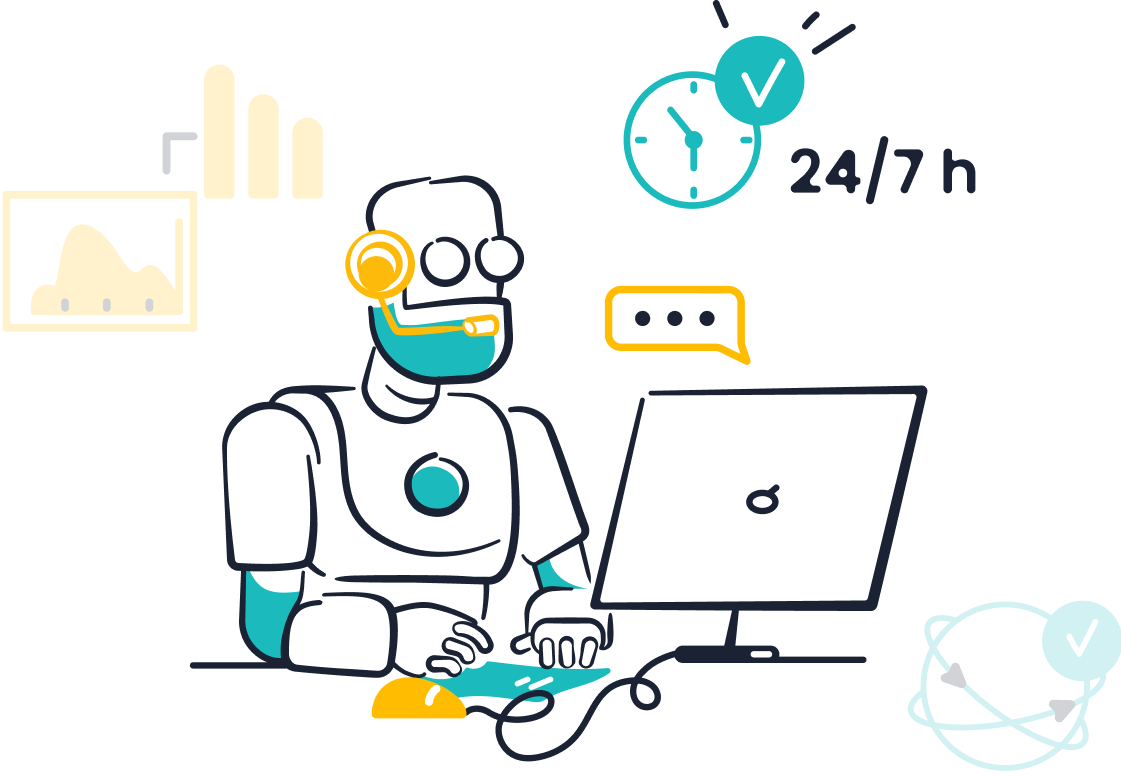Breaking Down Conversational AI and Generative AI Differences

Conversational AI refers to systems designed to replicate human-like interactions, particularly in customer service. These systems, like chatbots, enhance customer experiences by responding to queries and facilitating seamless human dialogue. For example, 80% of companies plan to adopt AI-powered chatbots by 2025, showcasing their growing impact.
On the other hand, generative AI creates new content, such as text, images, or audio, based on input data. Its applications range from generating marketing materials to automating creative processes. Studies reveal that generative AI can boost productivity in customer care by 30 to 45 percent.
The main difference lies in their purpose. Conversational AI focuses on interaction, while generative AI emphasizes creation. Understanding this distinction, especially when comparing conversational AI platform vs generative AI capabilities, helps businesses adopt the right tools. Sobot, a leader in AI solutions, exemplifies how these technologies transform industries.
Core Definitions of Conversational AI and Generative AI
What is Conversational AI?
Conversational AI refers to systems that enable human-like interactions through text or voice. You encounter these systems in customer support chatbots, virtual assistants, and communication platforms. They aim to understand and respond to natural language input, making conversations feel seamless and intuitive.
These systems rely on technologies like machine learning and natural language processing to interpret human speech and generate appropriate responses. For example, conversational AI can answer customer queries, assist with troubleshooting, or even schedule appointments. Businesses use conversational AI to improve customer service efficiency, reduce wait times, and enhance overall satisfaction.
A study shows that 69% of companies report improved consumer service after adopting conversational AI. Additionally, 55% of businesses experience decreased wait times, and 94% see boosted productivity among customer service specialists. These statistics highlight the transformative impact of conversational AI on customer interactions.
What is Generative AI?
Generative AI focuses on creating new content based on patterns learned from training data. You might recognize its applications in generating text, images, music, or even videos. Unlike conversational AI, which emphasizes interaction, generative AI excels in producing original and realistic outputs.
This technology uses deep learning techniques to analyze vast datasets and generate creative outputs. For instance, generative AI can write articles, design marketing materials, or compose music. It empowers businesses to automate creative processes, saving time and resources while maintaining high-quality results.
Generative AI has disrupted industries by enabling innovative solutions. Studies reveal that generative AI can boost productivity in customer care by 30 to 45 percent. Its ability to produce unique content makes it a valuable tool for marketing, branding, and customer engagement.
Technical foundations of conversational AI and generative AI
Conversational AI and generative AI share some underlying technologies, but their engineering foundations differ significantly. Conversational AI relies heavily on natural language processing and machine learning algorithms to understand and respond to human input. It focuses on creating interactive dialogue systems that mimic human communication.
Generative AI, on the other hand, uses deep learning models to generate new content. These models analyze patterns in training data and apply them to create realistic outputs. For example, generative AI can produce text that resembles human writing or images that look professionally designed.
Industry reports, such as the "2023 Conversational AI for Customer Service Landscape," define conversational AI as systems that use NLP and AI for automated assistance. Meanwhile, the "Emerging Tech Horizon for Generative AI" highlights the disruptive potential of generative AI in content creation and technology interactions.
Both technologies have unique strengths. Conversational AI excels in real-time interactions, while generative AI shines in creative tasks. Understanding their technical foundations helps you choose the right solution for your business needs.

Conversational AI Platform vs Generative AI: Key Technical Differences
Differences in architecture and design
The architecture of conversational AI platforms and generative AI models reflects their distinct purposes. Conversational AI platforms focus on enabling real-time interactions, while generative AI models prioritize creating new content.
| Feature | Conversational AI | Generative AI |
|---|---|---|
| Architecture | Primarily uses Natural Language Processing (NLP) and Dialogue Management | Utilizes architectures like GANs, VAEs, and Transformers |
| Training Data | Trained on human text conversations and recordings | Trained on diverse datasets to generate new outputs |
| Functionality | Engages in dialogue and solves problems | Generates creative content like text and images |
| Learning Mechanism | Reinforcement Learning from Human Feedback | Learns through adversarial processes or variational methods |
Conversational AI platforms rely on NLP and dialogue management systems to interpret user input and provide relevant responses. These platforms often use reinforcement learning to improve their ability to handle conversations over time. In contrast, generative AI models, such as those based on transformers, focus on text generation, image creation, and other creative tasks. They use advanced architectures like GANs (Generative Adversarial Networks) and VAEs (Variational Autoencoders) to produce high-quality outputs.
Data processing and training methodologies
The way conversational AI and generative AI process and train on data also differs significantly. Conversational AI platforms focus on understanding human language and context, while generative AI models aim to learn patterns for creating new content.
- Generative AI models, such as GPT-4, train on diverse texts to learn language patterns and structures.
- The quality of training data directly impacts AI performance. For example, studies show that experience-aware oversampling improves the quality of generated reviews.
- Contextual details, like version history, enhance model capabilities. Research highlights this in areas like code clone detection.
- Bias in training data can affect AI outputs. For instance, gender biases in software-trained models emphasize the need for bias mitigation.
- Studying prompts and conversation structures, as seen in the DevGPT dataset, improves understanding of AI interactions.
Conversational AI platforms process data differently. They analyze user input in real time, using NLP to extract meaning and intent. These platforms often incorporate feedback loops to refine their responses and improve accuracy. Generative AI models, however, require extensive pre-training on large datasets before they can generate meaningful outputs.
Outputs and their intended purposes
The outputs of conversational AI platforms and generative AI models serve different purposes. Conversational AI platforms aim to facilitate interactions, while generative AI models focus on creating diverse content.
| Aspect | Conversational AI | Generative AI |
|---|---|---|
| Purpose | Designed for specific interactions, such as mental health support. | Capable of generating diverse outputs across various domains. |
| Interaction Style | Often literal and straightforward, lacking depth in emotional understanding. | Can produce nuanced responses but may struggle with context. |
| Adaptability | Tailors responses based on user input, similar to a therapist's adaptability. | Generates outputs based on extensive datasets, potentially leading to biases. |
| Emotional Recognition | Limited ability to recognize and respond to emotional nuances. | May generate responses that lack emotional depth, affecting user experience. |
| Ethical Considerations | Requires safeguards to prevent misuse in sensitive contexts. | Must address biases in training data to ensure equitable healthcare. |
Conversational AI platforms excel in tasks like customer support, where quick and accurate responses are essential. They adapt to user input and provide tailored solutions. Generative AI models, on the other hand, shine in creative fields. They can generate marketing materials, write articles, or create images. However, their reliance on training data can lead to biases, which must be addressed to ensure fairness and accuracy.
Both technologies require ongoing evaluation to refine their outputs. Automated metrics and human-in-the-loop evaluations play a crucial role in assessing their performance. By understanding their differences, you can choose the right solution for your specific needs.
Use Cases and Applications in Customer Service

How conversational AI enhances customer interactions
Conversational AI transforms customer support by enabling faster, more personalized interactions. It uses natural language processing to understand customer queries and provide instant responses. This reduces wait times and improves satisfaction. For example, conversational AI can analyze past interactions to tailor responses, meeting customer expectations for personalized experiences.
| Metric | Description |
|---|---|
| Faster response times | Conversational AI provides instant responses, reducing customer wait times. |
| Improved personalization | AI can analyze past interactions to deliver tailored responses, meeting consumer expectations for personalization. |
| Shorter purchase cycles | By simplifying the customer experience, conversational AI encourages quicker purchasing decisions. |
| Lower agent burnout | Automating tasks with AI helps reduce the workload on customer service representatives, mitigating burnout risks. |
These benefits make conversational AI an essential tool for businesses aiming to enhance customer engagement and streamline operations.
Generative AI in content creation for customer engagement
Generative AI plays a pivotal role in creating engaging, AI-generated content for customer interactions. It analyzes extensive consumer data to produce tailored materials that resonate with individual preferences. This personalization significantly boosts customer engagement. For instance, platforms like Adobe Experience Platform use generative AI to create marketing assets at scale, ensuring content aligns with customer needs.
Generative AI also streamlines workflows by automating content creation. Businesses can generate diverse materials, such as product descriptions or promotional emails, in less time. This capability fosters long-term loyalty by delivering consistent, high-quality content. Research shows that integrating customer data with generative AI enhances hyper-personalization, building trust and improving customer satisfaction.
Sobot AI Chatbot: A practical example of conversational AI in action

The Sobot AI Chatbot exemplifies how conversational AI enhances customer support. It autonomously resolves regular queries, reducing inbound discussion volume by 20%. This allows human agents to focus on complex issues. The chatbot operates 24/7, ensuring customers receive assistance anytime.
| Metric/Outcome | Value/Result |
|---|---|
| Reduction in inbound discussion volume | 20% |
| Increase in positive feedback | 96%+ |
| Correct answers provided | Over 80% |
| Customer satisfaction | Over 95% |
| Self-service question resolution | 22.2% |
Sobot’s chatbot also improves customer satisfaction scores (CSAT) to 97% and boosts problem resolution rates to 85%. Its multilingual capabilities and no-coding-required setup make it accessible for businesses of all sizes. By integrating advanced AI, Sobot ensures efficient, personalized customer interactions, driving better outcomes for businesses.
Overlaps and Misconceptions Between Conversational AI and Generative AI
Areas where conversational AI and generative AI overlap
Conversational AI and generative AI share several functionalities, especially in customer service and marketing. Both can personalize user experiences by analyzing customer preferences and behaviors. For instance, they can create tailored marketing campaigns or generate product recommendations that resonate with individual needs.
Another area of overlap lies in content generation. Conversational AI uses generative AI models to craft responses that feel natural and engaging. This integration enhances conversational services, allowing businesses to deliver high-quality interactions. For example, a chatbot powered by generative AI can provide detailed product descriptions or suggest solutions to complex customer queries.
Both technologies also contribute to creative problem-solving. They analyze data to generate innovative solutions, such as addressing unique customer concerns or optimizing workflows. While their core purposes differ, their combined capabilities make them powerful tools for improving customer engagement and operational efficiency.
| Feature | Conversational AI | Generative AI |
|---|---|---|
| Focus | Understanding and responding to human language | Creating content based on user prompts |
| Data Dependency | Relies on language-based data and user interactions | Uses various datasets to generate content |
| Overlap | Can enhance conversational services with text-based AI | Can be used in conversational contexts |
Common misconceptions about their capabilities
Many people assume conversational AI and generative AI are interchangeable. This misunderstanding often stems from their overlapping functionalities. However, conversational AI focuses on interaction, while generative AI emphasizes creation.
Another misconception is that these technologies can operate without human oversight. In reality, both require proper implementation and monitoring to avoid issues like data biases or inaccuracies. For example, studies show that AI-driven platforms can debunk myths, such as those related to health, but only when trained on accurate and diverse datasets.
Some also believe AI can fully replace human roles. While AI enhances efficiency, it works best as a complement to human expertise. For instance, chatbots handle routine queries, but human agents remain essential for complex or emotionally sensitive interactions.
How to distinguish between the two in practical scenarios
You can differentiate conversational AI and generative AI by examining their characteristics and applications. Conversational AI typically follows predefined scripts or decision trees. It excels in structured interactions, such as answering FAQs or guiding users through processes.
Generative AI, on the other hand, uses machine learning to create dynamic responses. It generates diverse outputs, making it ideal for tasks like writing blog posts or designing marketing materials.
| Type of AI | Characteristics |
|---|---|
| Conversational AI | Typically rule-based, following predefined scripts and decision trees. |
| Generative AI | Utilizes machine learning to generate responses dynamically for varied interaction. |
In practical terms, conversational AI suits scenarios requiring real-time interaction, such as customer support. Generative AI shines in creative fields, where producing unique content is the primary goal. By understanding these distinctions, you can choose the right AI solution for your needs.
Future Trends in Conversational AI and Generative AI

Emerging advancements in conversational AI for customer service
Conversational AI continues to evolve, bringing transformative changes to customer service. Machine learning advancements have significantly improved the ability of AI systems to understand and respond to human language. Natural language processing breakthroughs now allow AI to interpret complex queries more accurately, enhancing user interactions.
The rise of multimodal AI has also expanded the capabilities of conversational AI. By integrating text, voice, and visual communication, these systems provide a more versatile and user-friendly experience. For example, a chatbot can now combine voice recognition with text-based responses to assist customers more effectively. Personalization has become another key trend. AI systems analyze user data to tailor responses, creating a more engaging and satisfying experience.
Ethical considerations are shaping the future of conversational AI. Developers are focusing on privacy and data security to ensure responsible use of AI technologies. These advancements make conversational AI an indispensable tool for businesses aiming to improve customer service.
Innovations in generative AI for content creation
Generative AI is revolutionizing content creation by automating processes and delivering high-quality outputs. Businesses use it to generate marketing materials, product descriptions, and even personalized emails. This capability saves time and resources while maintaining creativity and relevance.
Generative AI models, such as transformers, analyze vast datasets to produce realistic and unique content. For instance, they can create promotional videos or design visually appealing advertisements. The ability to generate diverse outputs makes generative AI a valuable asset for industries like marketing and e-commerce.
Market research highlights the growing impact of generative AI. By 2030, its market size is projected to reach $49.9 billion, with a compound annual growth rate (CAGR) of 24.9%. These figures underscore the increasing adoption of generative AI across various sectors.
How Sobot integrates conversational AI and generative AI for better customer experiences
Sobot combines conversational AI and generative AI to deliver exceptional customer experiences. Its conversational AI capabilities enable sophisticated interactions, maintaining context and understanding complex queries. This ensures customers receive accurate and timely assistance.
Generative AI enhances efficiency by automating tasks like generating call summaries and follow-up emails. This reduces the workload on human agents and improves overall productivity. Sobot also employs predictive analytics to anticipate customer needs, enabling proactive support.
By integrating these technologies, Sobot provides a seamless and personalized customer experience. Businesses using Sobot’s solutions benefit from improved engagement, higher satisfaction rates, and enhanced operational efficiency.
Understanding the differences between conversational AI and generative AI helps you choose the right tools for your business. Conversational AI focuses on interaction, enabling real-time communication with customers. Generative AI, on the other hand, creates new content, such as text or images, to enhance engagement.
For businesses, especially in customer service, these technologies offer unique advantages. Conversational AI improves customer interactions by providing instant support. Generative AI boosts creativity, helping you design personalized content. By recognizing their distinct purposes, you can better align these tools with your goals and deliver exceptional support experiences.
FAQ
What is the main difference between conversational AI and generative AI?
Conversational AI focuses on enabling real-time interactions, like answering customer queries. Generative AI creates new content, such as text or images, based on patterns in data. While conversational AI emphasizes communication, generative AI excels in creativity.
Tip: Think of conversational AI as a helpful assistant and generative AI as a creative artist.
Can conversational AI and generative AI work together?
Yes, they can complement each other. For example, a chatbot (conversational AI) can use generative AI to craft detailed, personalized responses. This combination enhances customer interactions by making them more engaging and informative.
How does Sobot use conversational AI and generative AI?
Sobot integrates conversational AI for real-time customer support and generative AI for tasks like creating call summaries. This blend improves efficiency, reduces agent workload, and ensures personalized customer experiences.
Is generative AI suitable for customer service?
Generative AI works well for creating content like emails or FAQs. However, it lacks the real-time interaction capabilities of conversational AI. Combining both technologies ensures better customer service.
Note: Use generative AI for creativity and conversational AI for communication.
Do I need technical skills to use Sobot’s AI solutions?
No, Sobot’s AI tools are user-friendly. The chatbot, for instance, features a point-and-click interface. You can set it up without coding knowledge, making it accessible for businesses of all sizes.
Emoji: 🚀 Start your AI journey with ease using Sobot’s intuitive tools!
See Also
Exploring AI Solutions for Enterprise Call Centers
Best 10 AI Tools for Enterprise Contact Centers
Comprehensive Guide to AI Software for Call Centers